How to Create a Registration Link for an Event: A Step-by-Step Guide

Lisa Broom | Head of Marketing
To learn how to create a registration link for an event, follow these steps: choose a registration platform, set up your event page, design the registration form, and generate your link. This guide will break down each step, making it simple to manage and track event registrations.
Key Takeaways
- Event registration links simplify the sign-up process, making it easy for attendees to register, purchase tickets, and access event details.
- Choosing the right event registration platform is key; look for user-friendliness, customization options, and integrations with other tools for efficiency.
- Effective promotion of your registration link with social media, email campaigns, and QR codes can significantly increase visibility and attendee engagement.
Understanding Event Registration Links
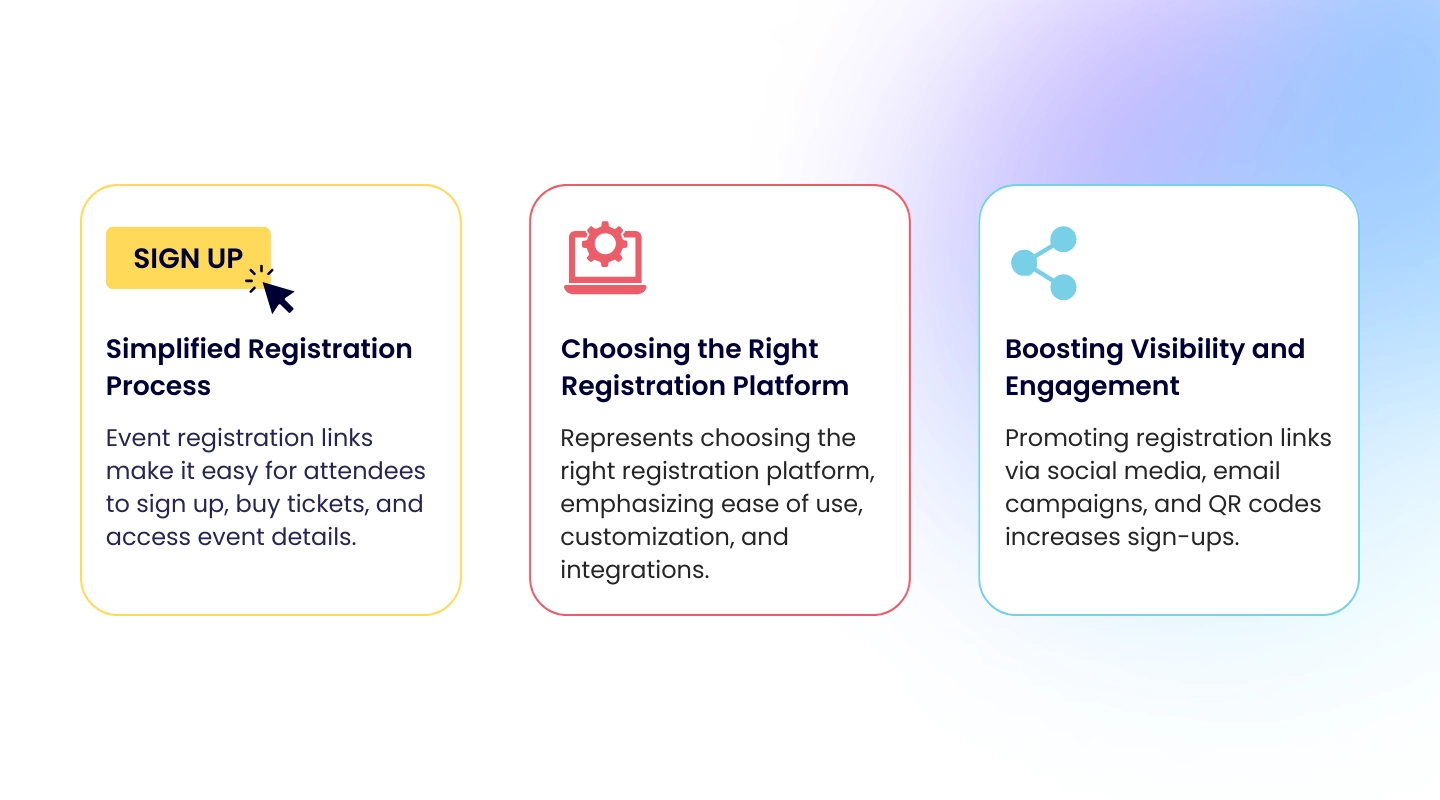
An event registration link is a unique web address that directs attendees to register for an event, efficiently managing attendee commitments and facilitating the registration process. These links serve as a gateway, allowing event organizers to collect essential attendee information, manage participant numbers, and streamline communication. Additionally, a link for an event can enhance the overall registration experience.
Event registration links streamline data collection, enhance the attendee experience, save time, reduce administrative tasks, and ensure a professional event registration process for organizers through effective event registration posts.
Attendees can access event details, complete sign-up, purchase tickets, and select seating through these event pages for event attendees, making the entire ticket sales process seamless and straightforward.
Choosing the Right Event Registration Platform
Choosing the right event registration platform is vital for managing your event successfully. A good platform can distinguish between a smooth, professional process and a chaotic one. It should offer a user-friendly interface, customizable options, and seamless integration with other tools to streamline management and improve efficiency.
Prioritize platforms with customization, user-friendliness, and tool integration to enhance the experience for organizers and attendees, making the process more efficient and enjoyable.
In the following subsections, we will delve into the essential features to look for in a platform, the importance of user experience, and the need for integration options.
Assessing Platform Features
Assess the features offered by event registration platforms, such as online registration forms, payment processing, attendee management, communication tools, and reporting/analytics. A digital ticketing platform should include customizable forms, secure payment gateways, registration analytics, and automated emails.
Platforms with customizable fields, conditional workflows, easy data export to spreadsheets or CRMs, and multiple payment methods enhance the registration process’s convenience and accessibility.
Evaluating User Experience
A user-friendly event registration platform should feature a clear layout, intuitive design, and straightforward functionality. Mapping out the entire registration journey enhances user understanding and eases the process.
With the growing trend of online promotions, a seamless registration process is crucial. A well-designed platform ensures minimal hassle for attendees, leading to higher registration rates and a better overall experience.
Considering Integration Options
Integration with CRM systems and email marketing tools is important for effective event management. Platforms should also integrate with marketing automation tools, social media, and payment gateways to streamline processes and enhance attendee experiences through targeted messaging.
Promoting events on social media can increase visibility, especially when integrated with other marketing tools. Adopting a self-serve system for adding necessary integrations can help manage registrations effectively.
Steps to Create a Registration Link for Your Event using Fliplet
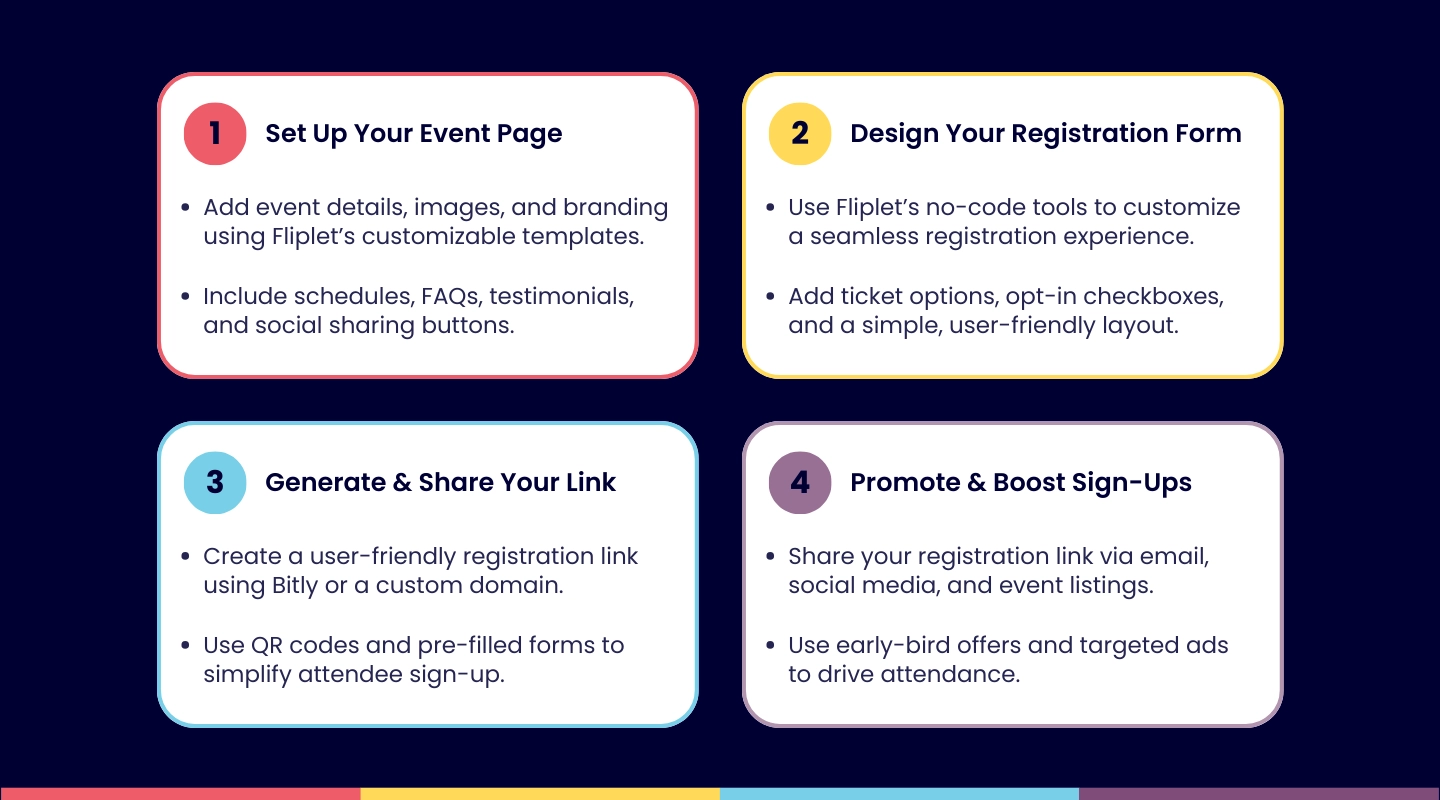
Having covered the essentials of choosing a platform, we now move to the practical steps of creating a registration link using Fliplet. Fliplet simplifies the entire process, from setting up your event page to designing the registration form and generating the registration link.
The upcoming subsections will guide you through setting up your event page, designing the registration form, and generating the registration link, preparing you to create a professional and efficient event registration page registration process.
Setting Up Your Event Page
Log into Fliplet and create your event. Place the event page based on your registration platform’s features and layout options. Add essential details like event title, date, location, and a relevant image. Customize with templates, logos, banners, fonts, and colors for a visually appealing layout.
Include essential elements on the event page, such as the event’s schedule, FAQs, testimonials, and social sharing buttons, which provide valuable information and enhance the overall appeal.
Designing the Registration Form
Platforms like Fliplet offer a no-code interface for easy creation of event registration forms. Customizing forms to meet the event’s specific needs ensures functionality and sets a positive tone.
Enhance the event registration form experience by incorporating opt-in checkboxes for newsletters and a variety of ticket types. A straightforward and easy-to-complete event registration form template encourages more attendees to register.
Generating the Registration Link
After setting up your event page and registration form, generate the registration link. Use URL shortening services like Bitly or a custom domain for a user-friendly link, ensuring it directs attendees to a seamless sign-up and participation management page.
Include a pre-fill information option to simplify registration for repeat attendees. QR codes allow quick access to registration forms via smartphones, and an immediate confirmation of registration completion can be provided through a Thank You Page.
Promoting Your Event Registration Link
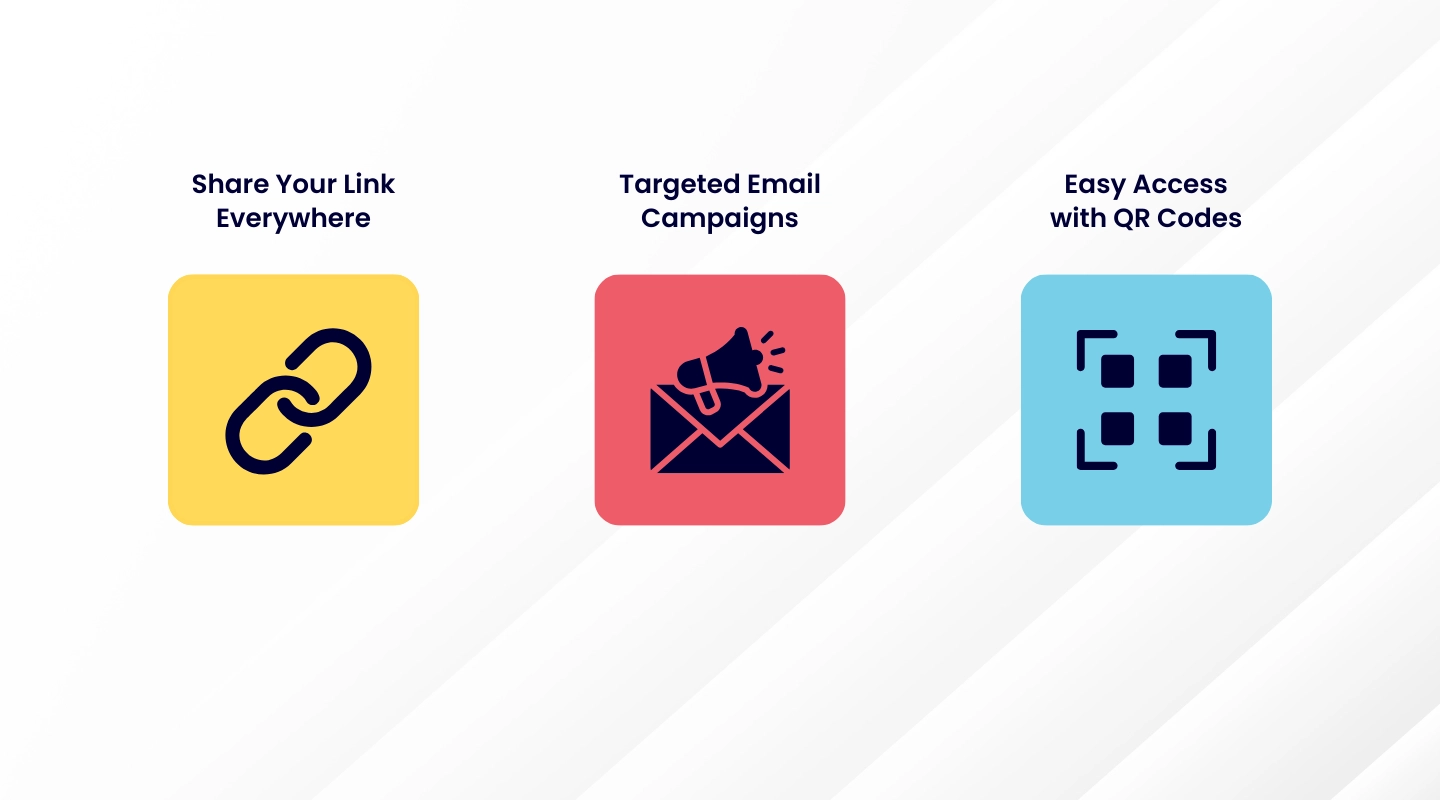
Promote your event registration link through email newsletters, social media platforms, event listing websites, and online communities to reach a wider audience. Engaging content formats, like videos, can capture potential attendees’ interest and enhance visibility.
Encourage prompt registration with early-bird discounts or special promotions. Include the registration page link in targeted email campaigns for specific audience segments.
Leveraging Social Media Platforms
Social media can greatly enhance event visibility and engage potential attendees, with about 30% of U.S. marketers finding it effective for attracting new attendees. Influencer partnerships can further promote registration links by tapping into established audiences.
Promote your event registration link on Facebook by advertising on pages and groups, and on LinkedIn by sharing the unique event URL in posts and messages.
Community-building, polls, and giveaways can enhance audience engagement on social media.
Email Marketing Campaigns
Email marketing platforms offer automated drip campaigns, A/B testing, and performance tracking features to optimize registration. Customize email campaign messages for different audience segments to improve engagement. Personalizing emails based on the recipient’s journey can significantly boost engagement and conversion rates.
Include the event registration link in your email newsletters and targeted campaigns to reach a broad audience and encourage registrations.
Utilizing QR Codes
QR codes offer a convenient way for attendees to access registration links quickly, providing a seamless experience. Test QR codes before sharing to ensure they link effectively to registration pages.
Include QR codes in promotional materials, email campaigns, and social media posts to make registration easy for potential attendees.
Managing Event Registrations
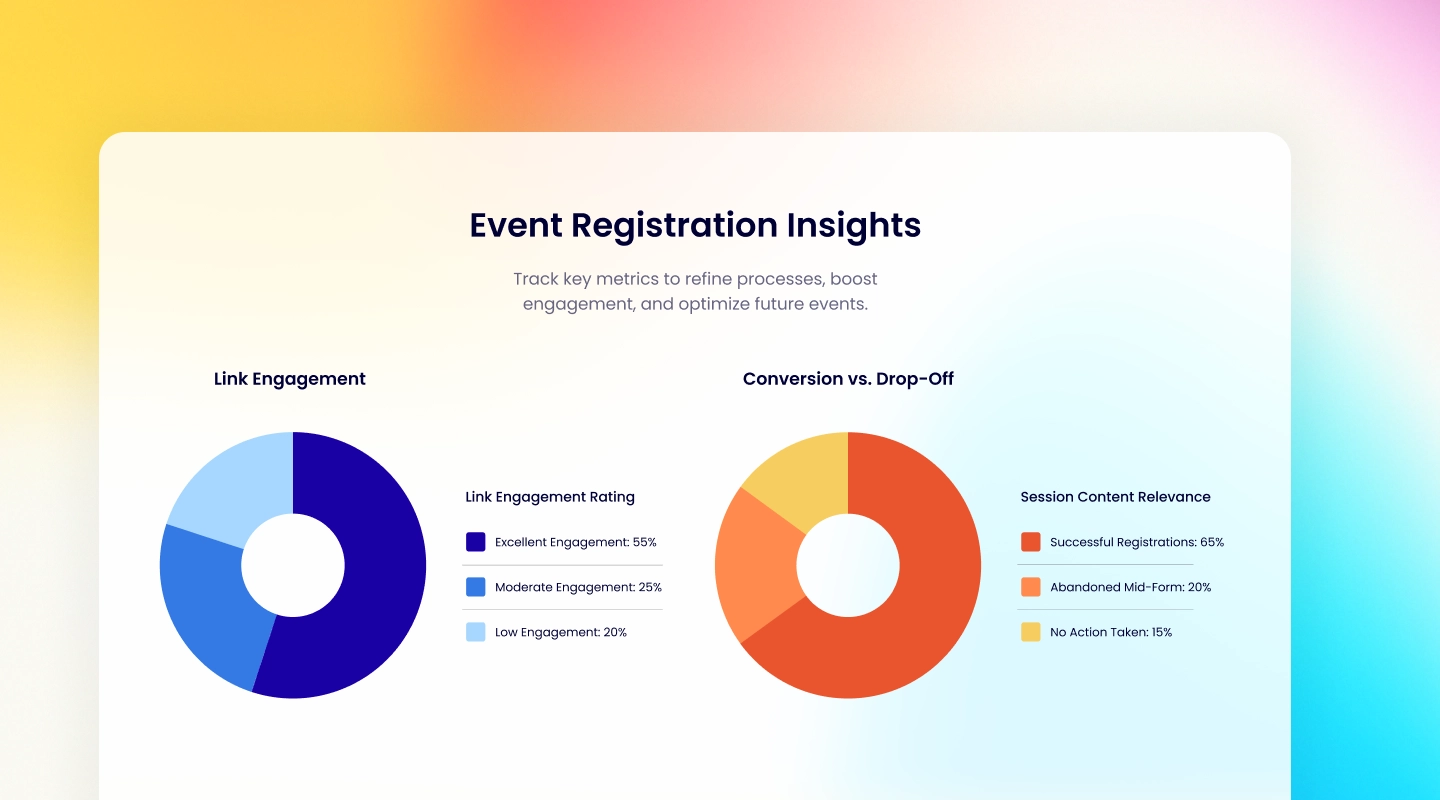
Effective management of event registrations is crucial for success. An efficient system simplifies the sign-up process, saving time and effort, while registration links enhance attendee engagement by facilitating connections and access to real-time updates.
Secure online payment processing through registration links enhances attendee satisfaction and reduces administrative tasks. These links also support hybrid events by allowing attendees to choose their preferred mode of participation.
Monitoring Registration Data
Analyzing registration data helps refine forms for increased efficiency and conversion rates. Tracking click-through rates, conversion rates, and drop-off points is key to optimizing the process. Real-time tracking of registrations supports data-driven decision-making in event planning.
Event registration analytics tools offer powerful insights into attendee behavior. Adjusting the registration process based on these insights can significantly improve user experience. Detailed metrics reveal user funnels, visitor interactions, drop-off points, and submission completions, providing comprehensive insights.
Handling Payment Processing
Ensure the event registration platform connects with popular payment gateways for secure transactions, uses advanced encryption protocols, and complies with industry standards. A secure payment gateway integration collects payments conveniently, ensuring peace of mind for both planners and attendees.
Online event registration forms typically include secure payment gateway integrations for various payment methods, including an online registration form for google forms event registration for easy data collection. Test payment processing before sending out the registration link to ensure functionality.
Automatically provide attendees with confirmation emails and receipts after successful payment and registration.
Providing Support and Assistance
Technical support during event registration is crucial for assisting attendees with any difficulties. Event organizers can use customer support tools like Event Smart to provide robust assistance. Timely support during registration is vital for assisting attendees with any technical issues.
Providing attendees with relevant information and a step-by-step guide can help mitigate issues and improve the registration experience.
Post-Event Activities
Post-event activities are essential for measuring success and planning future events. Real-time analytics from registration systems help organizers measure success and attendee satisfaction. Surveys or direct feedback mechanisms gather valuable attendee insights on the registration process.
Advanced registration platforms facilitate comprehensive data collection to understand attendee preferences and improve future events, enhancing overall event experience and success.
Sending Thank-You Emails
Sending thank-you emails promptly after an event strengthens attendee relationships and enhances the likelihood of future participation. Personalizing thank-you emails with specific mentions of a recipient’s contributions can significantly enhance engagement.
Including a call to action in thank-you emails can motivate attendees to engage with future events or provide feedback, leaving a lasting positive impression.
Analyzing Event Success
Tracking registrations is crucial for measuring event success, while analyzing attendee data aids in making informed decisions for future events. Gather feedback through post-event surveys to gain insights into areas for improvement. Surveying attendees directly gauges their satisfaction and highlights areas for improvement.
Post-event social media engagement data helps assess overall reach and impact, while understanding the cost-to-revenue ratio assesses financial viability. These analyses refine event planning strategies, ensuring future events are even more successful.
Summary
Creating a registration link for your event is a multi-faceted process that involves careful planning, strategic platform selection, and effective promotion. By understanding the importance of event registration links, choosing the right platform, and following a detailed step-by-step guide, you can streamline the registration process and enhance the overall attendee experience.
Efficiently managing event registrations, handling payments securely, providing robust support, and conducting thorough post-event analyses are crucial for the success of any event. With these insights and tools at your disposal, you’re well on your way to hosting a successful and memorable event.
FAQs
What is an event registration link and why is it important?
An event registration link is a unique URL that allows attendees to sign up for an event, making it essential for managing registrations and improving the overall experience. Having a dedicated link ensures a smooth process and keeps everything organized.
How do I choose the right event registration platform?
To choose the right event registration platform, focus on customization, user-friendliness, and how well it integrates with other tools you use. Make sure to evaluate the features and overall user experience to find the best fit for your needs.
What are the steps to create a registration link using Fliplet?
To create a registration link using Fliplet, first set up your event page and design a user-friendly registration form. Then, generate the link using a URL shortener or a custom domain to make it easy to share.
How can I promote my event registration link effectively?
To effectively promote your event registration link, leverage email newsletters and social media, along with event listing websites. Don’t forget to use engaging content and consider offering early-bird discounts to drive quick sign-ups!
What are the key post-event activities to ensure future event success?
To ensure future event success, it’s crucial to send personalized thank-you emails and gather feedback through surveys. Analyzing registration data and evaluating the overall event performance will help inform your strategies moving forward.





